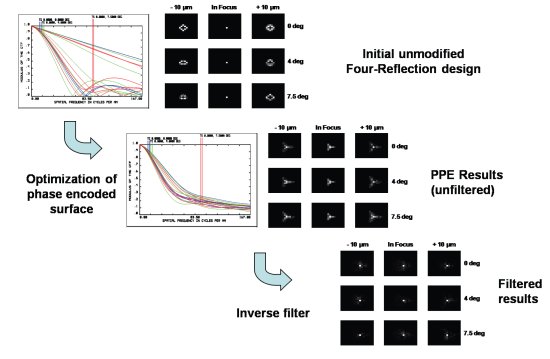Photonic Systems Integration
Laboratory
Pupil-Phase Encoding & Post-Processing
In recent years hybrid optical-digital approaches have been investigated to modify the performance of imaging systems using joint optimization of the system’s optical and digital degrees of freedom [See for example: Appl. Opt. 41, 6080-6092 (2002)]. We have applied this approach to our CMR camera designs to increase the fabrication tolerances while simultaneously extending the depth of focus & depth of field. Pupil-phase encoding combined with post-detection processing reduces these problems by providing the system designer with the ability to trade off best focus performance for more tolerance to optical aberrations. This increased tolerance can then be budgeted to relax the alignment or fabrication tolerances, or to extend the system’s tolerance to optical aberrations such as defocus.
(Below) Pupil-phase encoding applied to the four-reflection design

For more information:
Download selected presentation slides (pdf)
Publication:
E. J. Tremblay, J. Rutkowski, I. Tamayo, P. E. X. Silverira, R. A. Stack, R. L. Morrison, M. A. Neifeld, Y. Fainman, and J. E. Ford, “Relaxing the alignment and fabrication tolerances of thin annular folded imaging systems using Wavefront Coding,” Applied Optics,Vol.46, No. 27 (accept for publication June 2007).